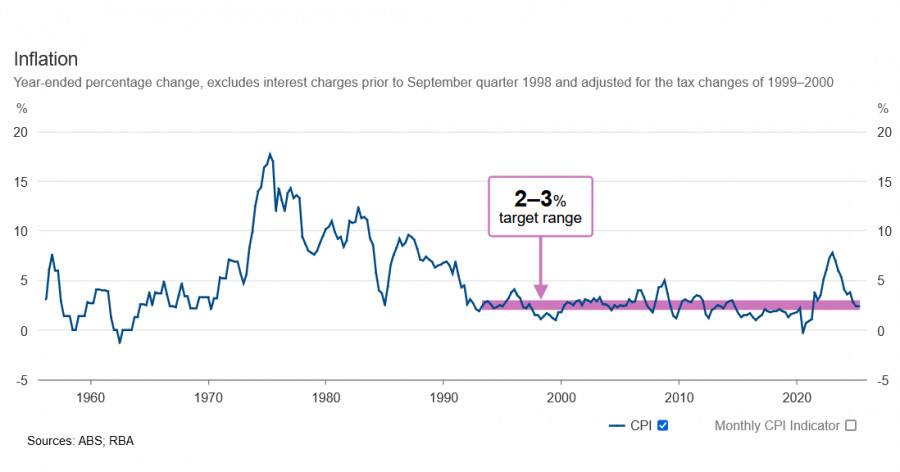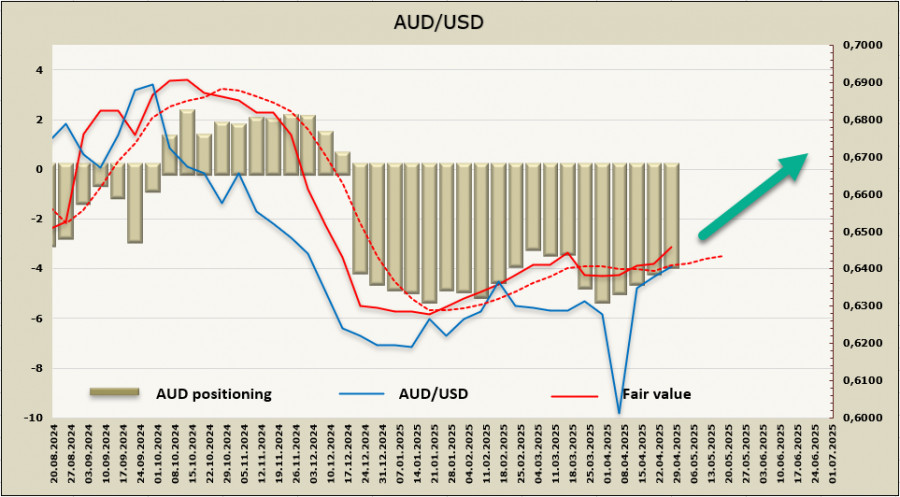See also


 30.04.2025 01:03 PM
30.04.2025 01:03 PMInflation in Australia remained steady at 2.4% year-over-year in Q1, defying expectations of a slight slowdown to 2.2%. The quarterly increase of 0.9% also exceeded forecasts, while core inflation slowed from 3.3% to 2.9%, which can be seen as significant progress as it entered the Reserve Bank of Australia's (RBA) target range of 2–3%.
toward normalization, cutting the rate from 4.35% to 4.10%.
There's no need for haste, as the economy remains resilient. At its February meeting, the RBA expressed confidence in accelerating economic growth and a robust labor market. However, this was before the world learned about the U.S. announcement of a "Liberation Day" and the heightened global uncertainty that followed.
Currently, interest rate forecasts suggest the next rate cut could come as early as the May 20 meeting, followed by two more reductions before the end of the year. This is a fairly moderate pace that would help maintain high yield appeal, which in turn should prevent a sharp drop in the Australian dollar — even in the event of a global downturn.
In contrast, uncertainty surrounding the U.S. economy continues to grow. Today, the initial estimate for Q1 GDP will be released, showing how the economy responded during the first 100 days of President Trump's second term. The consensus forecast calls for a 0.8% year-over-year increase, but the Atlanta Fed's GDPNow model paints a much bleaker picture: a 2.7% contraction — potentially making this the worst quarter since mid-2020.
The market's response will depend on which projection is closer to reality. Any positive reading would likely be viewed as neutral, but if the data aligns with the GDPNow forecast, it will almost certainly trigger a wave of dollar selling, a drop in equity indices, and increased demand for bonds. In that case, the Australian dollar will most likely move in sync with broader market sentiment, as local data will take a back seat — or even a third-row seat — in terms of relevance.
Market Positioning and Outlook
The net short position on AUD narrowed by $259 million during the reporting week, to –$3.48 billion. Despite the increase in the estimated fair value and AUD's attempts to strengthen against the U.S. dollar, overall speculative positioning remains bearish, suggesting weak prospects for a sustained bullish trend.
Nonetheless, in the short term, AUD/USD is expected to continue attempting upward movement, with the pair consolidating near the resistance zone at 0.6410/30. A bullish breakout appears more likely than a pullback to one of the support levels at 0.6320 or 0.6245, with an upward target of 0.6540/60.
You have already liked this post today
*The market analysis posted here is meant to increase your awareness, but not to give instructions to make a trade.


